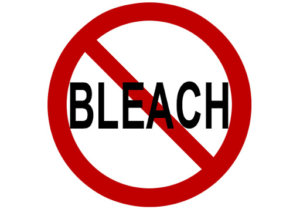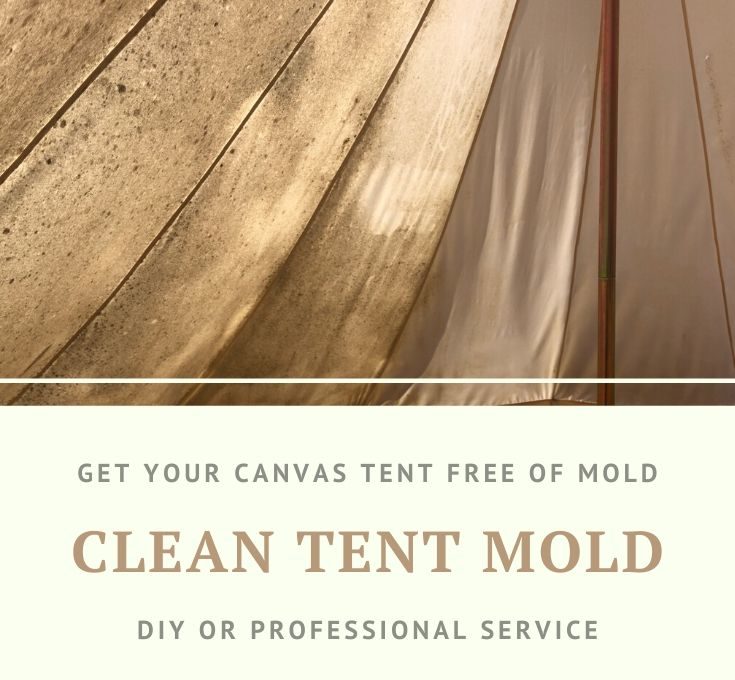Why You Should Never Use Vinegar or Bleach on Canvas
Do you have mold on your canvas tent or pop-up trailer and want to clean it off without damaging the tent?
Mold growth is the most common way that a hearty canvas tent can be taken down. It’s caused by a combination of moisture and bacteria growing on the organic cotton fibers. While many canvas tents are treated to prevent mold and mildew growth (anti-fungal treatments), most of these treatments cover only a certain number of strains, it is not resistant to EVERY type of mold. The canvas we buy is guaranteed to cover the top 500 strains of mold in North America.
However, other strains can still cause you problems. We’ve been fortunate/unfortunate enough to have maintenance requests sent in for all types of canvas tents, even canvas pop-trailers, like Starcraft campers, roof-top tents, canvas wall tents, elk tents, hunting tents, backpacking tents, tipis, glamping tents, and of course, bell tents. We maintain over 1,000 tents a year, and our team has field experience with tents in all sorts of conditions. We have wholesale/commercial clients throughout the US and the world, including challenging sites like in Hawaii, Florida, Pacific North West, and Costa Rica.
While some climates are more prone to mold, no matter where you are located, mold and mildew can be a problem if your canvas is not properly maintained. We store our rental fleets and handle the storage of our commercial clients, in hot/dry Arizona, and cold (sub-zero) Vermont. Mold doesn’t like either of these extreme temp situations.
There are tons of articles containing bad information on the internet about the use of vinegar on canvas tents. In fact, the top 10 articles on google all mention this tactic.
How did this bad advice get started? It’s possible that one person had some luck at one point, and posted about it, and then lots of uneducated, inexperienced people needed a solution and jumped on that bandwagon. Using vinegar to clean off mold sounds reasonable, chemical-free, and safe… BUT… it will damage and weaken your canvas, and your bug netting! Vinegar is caustic, which by definition means able to burn or corrode organic tissue by chemical action!
(Read all about how you SHOULD clean your tent here!)
Another terrible caustic item that is recommended is bleach. Bleach might work well for mold and mildew in a shower, but not on a high-quality canvas tent. Remember – using vinegar and bleach together creates a toxic chlorine gas.

Bleach can ruin your canvas tent
Now that we’ve cleared up that not only are bleach and vinegar CAUSTIC and damage the canvas, they also aren’t even EFFECTIVE.
Some brands of canvas tents mold faster than others. I’ve had a few calls over the years from chemical sensitive customers who wish to avoid the anti-fungal treatments that are sometimes on canvas. They’ll request ‘un-treated’ canvas. While we could certainly handle a custom request like that, we’ll often try to talk them out of that direction because we’ve seen how fast un-treated canvas will mold. It’s incredible. We once bought a roll of untreated canvas, and it was molded when we received it! Just a short 3-5 day drive from the factory in Georgia. We keep untreated canvas around, just so that we can send it out as a sample swatch with our other canvas swatches.
When both pieces are laid out and left to their own against the elements – the untreated canvas will show signs of mold in just 3-4 days. The treated canvas on average take up to 30 days.
There are cheap knock-off canvas tents on the market (typically imported from China or Pakistan- like Dreamhouse, Danchel, and White Duck Outfitters) and they are NOT made with real canvas. We bought and inspected those tents and discovered they use a cotton material with a thin layer of laminate (think of Grandma’s old table-cloth). Unfortunately, when they mold, we are unable to treat them. In this case the mold tends to grow between the laminate layer and the canvas layer, and when we try to treat the mold, the two sometimes separate/delaminate, or you don’t see any results at all. The other issue with these kinds of materials is that they are also impossible to sew repairs on. The needle will rip the material, and puncture holes in the tent, which is why many of these tents require seam sealing with a laminate tape. That laminate tape never sticks for long, and ends up hanging down and then eventually being pulled off, kind of like the way scotch tape can only be used once, or it loses it’s stickiness.
Here’s Our Pro Tips to Avoid and Treat Mold on Your Canvas Tent
1. Make sure your tent is REAL true canvas
2. Make sure it is TREATED canvas
3. Store it completely DRY
4. If you run into a problem, follow our cleaning steps
5. Avoid tent manufacturers that don’t know best practices for canvas

